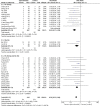Chinese Herbal Medicine for Reducing Chemotherapy-Associated Side-Effects in Breast Cancer Patients: A Systematic Review and Meta-Analysis
- PMID: 33363030
- PMCID: PMC7756083
- DOI: 10.3389/fonc.2020.599073
Chinese Herbal Medicine for Reducing Chemotherapy-Associated Side-Effects in Breast Cancer Patients: A Systematic Review and Meta-Analysis
Abstract
Background: Chemotherapy usually induces a variety of side-effects in cancer treatment as it cannot tell normal cells apart from cancer cells and kills both. Chinese herbal medicine (CHM) has been regarded as a potential effective intervention for relieving the side-effects of chemotherapy in breast cancer patients.
Objective: This study aims to conduct a comprehensive systematic review and meta-analysis to evaluate the efficacy of CHM as adjuvant therapy for reducing the chemotherapy-induced side-effects in the treatment of breast cancer.
Methods: Main electronic databases were searched up to May 2020 for Randomized Controlled Trials (RCTs) evaluating the effect of CHM on breast cancer patients with chemotherapy. The PRISMA statement was adopted in this study and meta-analyses were performed.
Results: The included studies showed unsatisfied quality. Results based on available literature indicated that the adjunctive use of CHM with chemotherapy may reduce the chemotherapeutic agents-associated adverse events, including nausea and vomiting, diarrhea, alopecia, myelosuppression, and impaired immune function.
Conclusion: A confident conclusion could not be have due to the lack of large scale and high quality trials.
Keywords: breast cancer; chemotherapy; herbal medicine; meta-analysis; side effect.
Copyright © 2020 Li, So, Tang, Tan, Wang, Ng, Chan, Yu and Feng.
Conflict of interest statement
The authors declare that the research was conducted in the absence of any commercial or financial relationships that could be construed as a potential conflict of interest.
Figures






















Similar articles
-
Efficacy and Safety of Chinese Herbal Medicine on Ovarian Cancer After Reduction Surgery and Adjuvant Chemotherapy: A Systematic Review and Meta-Analysis.Front Oncol. 2019 Aug 16;9:730. doi: 10.3389/fonc.2019.00730. eCollection 2019. Front Oncol. 2019. PMID: 31475101 Free PMC article.
-
Chinese Herbal Medicine as an Adjunctive Therapy for Breast Cancer: A Systematic Review and Meta-Analysis.Evid Based Complement Alternat Med. 2016;2016:9469276. doi: 10.1155/2016/9469276. Epub 2016 May 9. Evid Based Complement Alternat Med. 2016. PMID: 27239216 Free PMC article. Review.
-
Chinese Herbal Medicine as Adjunctive Therapy to Chemotherapy for Breast Cancer: A Systematic Review and Meta-Analysis.Evid Based Complement Alternat Med. 2016;2016:3281968. doi: 10.1155/2016/3281968. Epub 2016 Apr 10. Evid Based Complement Alternat Med. 2016. PMID: 27190531 Free PMC article. Review.
-
Chinese Herbal Medicine for Chemotherapy-Induced Leukopenia: A Systematic Review and Meta-Analysis of High-Quality Randomized Controlled Trials.Front Pharmacol. 2021 May 4;12:573500. doi: 10.3389/fphar.2021.573500. eCollection 2021. Front Pharmacol. 2021. PMID: 34017246 Free PMC article. Review.
-
Oral Chinese Herbal Medicine as an Adjuvant Treatment for Chemotherapy, or Radiotherapy, Induced Myelosuppression: A Systematic Review and Meta-Analysis of Randomized Controlled Trials.Evid Based Complement Alternat Med. 2017;2017:3432750. doi: 10.1155/2017/3432750. Epub 2017 Aug 10. Evid Based Complement Alternat Med. 2017. PMID: 28855947 Free PMC article. Review.
Cited by
-
Harnessing the nutriceutics in early-stage breast cancer: mechanisms, combinational therapy, and drug delivery.J Nanobiotechnology. 2024 Sep 18;22(1):574. doi: 10.1186/s12951-024-02815-8. J Nanobiotechnology. 2024. PMID: 39294665 Free PMC article. Review.
-
Anti-Breast Cancer Effects of Thymoquinone-Chemotherapeutic Combinations: A Systematic Review of the Latest In Vitro and In Vivo Studies.J Clin Med Res. 2025 May;17(5):270-284. doi: 10.14740/jocmr6230. Epub 2025 May 28. J Clin Med Res. 2025. PMID: 40503065 Free PMC article.
-
Case report: Herbal treatment of neutropenic enterocolitis after chemotherapy for breast cancer.Open Life Sci. 2023 Oct 24;18(1):20220753. doi: 10.1515/biol-2022-0753. eCollection 2023. Open Life Sci. 2023. PMID: 37941783 Free PMC article.
-
Traditional herbal medicine combined with first-line platinum-based chemotherapy for advanced non-small-cell lung cancer: A PRISMA-compliant systematic review and meta-analysis.Medicine (Baltimore). 2021 Sep 17;100(37):e27163. doi: 10.1097/MD.0000000000027163. Medicine (Baltimore). 2021. PMID: 34664842 Free PMC article.
-
Chitosan oligosaccharide decorated liposomes combined with TH302 for photodynamic therapy in triple negative breast cancer.J Nanobiotechnology. 2021 May 19;19(1):147. doi: 10.1186/s12951-021-00891-8. J Nanobiotechnology. 2021. PMID: 34011362 Free PMC article.
References
Publication types
LinkOut - more resources
Full Text Sources

